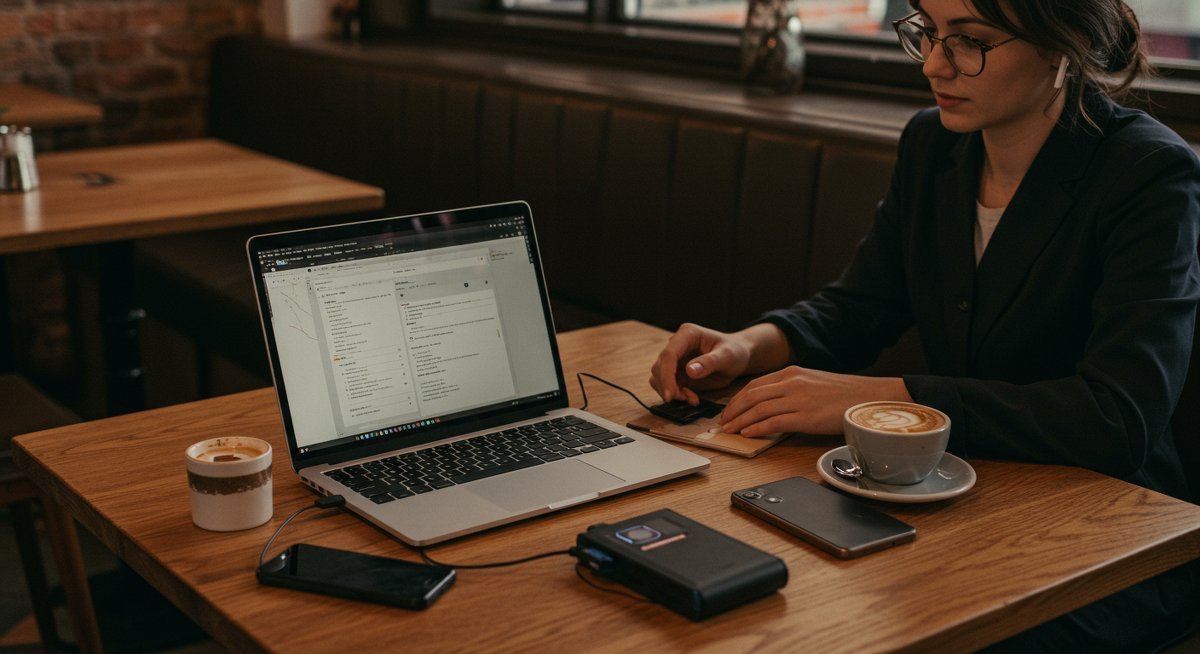Are you just starting your digital nomad journey and worried about keeping your devices charged? You're not alone! Staying connected is crucial for remote work, communication, and entertainment. This guide is designed specifically for aspiring digital nomads, offering practical advice on choosing and using portable power banks to ensure you stay powered up wherever your travels take you. We'll cover everything from understanding power bank basics to recommending the best models for 2025, making sure you're always ready to work or explore.

Why Embracing Portable Power Banks Matters for Your Nomad Journey
As a beginner nomad, you'll quickly realize that finding reliable power sources can be a daily challenge. Cafes might have limited outlets, co-working spaces can be crowded, and public transport rarely offers charging options. A good portable power bank provides a safety net, ensuring your devices stay charged, allowing you to work seamlessly, communicate with clients and loved ones, and navigate your new surroundings without interruption.
Consider these common scenarios:
- Working from a Train: You're on a long train journey, with no access to power outlets. A power bank allows you to continue working on your laptop or tablet, making the most of your travel time.
- Exploring Remote Locations: You're exploring a beautiful, off-the-grid location, but need to keep your phone charged for navigation and communication. A power bank enables you to capture photos, videos, and stay connected.
- Attending Conferences: You're attending a conference, and need to keep your phone and tablet charged for note-taking, networking, and accessing conference materials. A power bank offers the convenience of charging on the go.
Having a reliable power bank is a game-changer. It eliminates the stress of a low battery, allowing you to stay focused and productive, and enhances your overall digital nomad experience.
Essential First Steps to Becoming a Digital Nomad with Portable Power
Before you purchase your first power bank, there are several essential steps to consider. First, understand your power needs. Different devices consume different amounts of power. A smartphone typically needs less power than a laptop. Next, research the different types of power banks available. There are various sizes, capacities, and charging speeds. Finally, consider the features that are most important to you, such as fast charging, multiple ports, and durability. Here are some crucial considerations:
- Calculate Your Daily Power Consumption: Estimate how much power your devices use daily. This includes your phone, laptop, tablet, and any other gadgets. Check the battery capacity (in mAh or Wh) of your devices and estimate how many times you'll need to recharge them.
- Research Power Bank Types: Familiarize yourself with different power bank technologies, such as Lithium-ion and Lithium-polymer batteries, to determine the best fit for your needs.
- Understand Charging Speeds: Look for power banks that offer fast charging capabilities (e.g., USB-C Power Delivery) to minimize charging times.
Taking these initial steps will ensure that you choose a power bank that meets your specific needs and seamlessly integrates into your digital nomad lifestyle.
Common Beginner Challenges & How to Overcome Them
New digital nomads often face several challenges when integrating power banks into their workflow. One common issue is choosing a power bank that isn't powerful enough, leaving them with dead devices. Another is the misconception that any power bank will do. In reality, you need to consider capacity, charging speed, and portability. Furthermore, understanding the different charging protocols and port types (USB-A, USB-C) can be confusing. Here are some common pitfalls and how to avoid them:
- Insufficient Capacity: Buying a power bank with too little capacity. A power bank with a capacity of 10,000 mAh might only fully charge a laptop once, which might not be enough for a full day of work. Solution: Choose a power bank with a higher capacity (20,000 mAh or more) if you need to charge a laptop or multiple devices.
- Slow Charging Speeds: Using a power bank with slow charging speeds can be frustrating, especially when you're in a hurry. Solution: Select a power bank with fast charging capabilities, such as USB-C Power Delivery, to reduce charging times. Look for power banks with at least 18W output, or even higher for laptops.
- Ignoring Portability: Some power banks are bulky and heavy, making them difficult to carry around. Solution: Balance capacity with portability. Consider the size and weight of the power bank, and choose one that fits your travel style.
By addressing these challenges head-on, you'll be well on your way to seamless remote work.
Tips for Success (e.g., Budgeting, Finding Remote Jobs)
To make the most of your power bank investment, consider these tips:
Budgeting: Power banks vary greatly in price. Set a budget based on your needs and the features you require. Don't overspend on features you won't use, but don't skimp on quality if you need reliability.
Choosing the Right Capacity: A 10,000 mAh power bank is fine for smartphones and tablets. However, for laptops, aim for at least 20,000 mAh, especially if you work long hours and don't always have access to wall outlets. For example, the Anker PowerCore III Elite 25600 offers high capacity, ideal for multiple charges of various devices.
Finding Remote Work: Ensure your devices are charged so you can focus on work! Consider getting a power bank with multiple ports to charge your laptop and phone simultaneously.
Travel-Friendly Features: Look for power banks with travel-friendly features, such as built-in LED flashlights or sturdy designs. Make sure the power bank complies with airline regulations for carry-on luggage.
Proper Maintenance: Extend the life of your power bank by storing it in a cool, dry place and avoiding extreme temperatures. Regularly charge and discharge it to maintain its performance. Ensure the power bank is fully charged before a long trip.
By following these tips, you can ensure your power bank serves you well during your travels and work.
Building a Sustainable Nomad Lifestyle
Integrating a power bank into your lifestyle is more than just keeping your devices charged. It's about building a reliable and sustainable workflow that allows you to work from anywhere. When choosing a power bank, prioritize features like durability and long-term performance. Make sure the power bank is built with quality materials. For example, the Goal Zero Sherpa 100PD is known for its rugged design and high capacity, making it perfect for outdoor adventures as well as remote work scenarios.
- Durability: Opt for power banks with a rugged design, especially if you anticipate working in challenging environments. Look for features like water resistance and drop protection.
- Long-term performance: Power banks degrade over time. Choose a power bank from a reputable brand, with a good warranty, to ensure you can rely on it for years to come.
- Efficient Charging Habits: Develop a habit of charging your devices overnight or whenever you have access to a power outlet. This ensures your power bank is fully charged and ready to go when you need it.
Integrating these practices will make your work much easier.

Recommended Resources for New Nomads
To further enhance your digital nomad journey, consider these resources:
- Product Review Websites: Websites like Wirecutter, TechRadar, and PCMag offer comprehensive reviews and comparisons of power banks, helping you make informed purchasing decisions.
- Nomad Communities: Online forums and social media groups (e.g., Reddit's r/digitalnomad) offer advice, tips, and recommendations from experienced nomads. Seek recommendations for specific power bank brands and models.
- Travel Blogs: Travel blogs often feature product reviews and recommendations. Many nomads share their experiences with different power banks.
Utilizing these resources can significantly improve your power management skills and assist you in selecting the ideal power bank.
Quick Wins for Your First Nomad Trip
Before your first nomad trip, make sure you have a suitable power bank. Assess your power needs, choose a high-quality power bank, and test it with your devices before you leave. Always carry a charging cable and adapter with you.
- Assess your power needs: Before you leave, calculate your average daily power consumption to ensure your power bank has enough capacity.
- Choose a high-quality power bank: Invest in a reputable brand that offers reliability and durability.
- Test before you leave: Fully charge your devices and your power bank to ensure everything is working correctly.
By preparing in advance, you can enjoy a seamless digital nomad experience.
Next Steps in Your Location Independent Life
As you become more experienced, you can explore advanced power solutions, like solar chargers or larger portable power stations, for longer trips or off-grid adventures. Consider investing in a power bank with more advanced features, like wireless charging or multiple charging ports. Keep exploring and experimenting with different power solutions to find what works best for your lifestyle.
- Explore Solar Chargers: For sustainable energy, consider investing in a portable solar charger that can recharge your power bank while you're on the go. Brands like BigBlue offer foldable solar panels ideal for digital nomads.
- Review Your Workflow Regularly: As your work and travel patterns change, reassess your power needs and update your setup. The best power bank today might not be the best in a year or two.
By continuously seeking ways to improve your power management skills, you'll be well-prepared to thrive in your nomadic life. " , "tags_used": [ "digital-nomad-tools", "beginner-nomads", "tech-essentials", "finding-community", "review", "benefit-productivity", "remote-work-setup" ], "structure_selected": "beginner-nomads